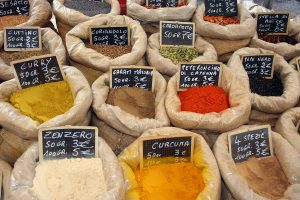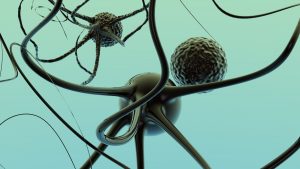Curcumin, an ancient medicine for aging and lifestyle diseases

A natural anti-inflammatory compound.
Inflammation isn’t necessarily a bad thing. It is a natural reaction of the body when tissues are damaged, or harmful bacteria or viruses are present. The inflammation then develops and enables damaged tissue repair itself, and the body to fight against harmful intruders.
Unfortunately, there can also the presence of a chronic inflammation. Chronic inflammation will eventually turn against the body’s own cells and tissues, and can cause damage. In fact, more and more scientists think that inflammation might play a role in almost all lifestyle diseases. These include cardiovascular disease, cancer, Alzheimer’s disease, osteoarthritis, rheumatoid arthritis and other degenerative disorders [1,2,3].
The treatment of chronic inflammation could therefore be preventive against the onset of these diseases and conditions. Furthermore, scientific research has shown that the anti-inflammatory effect is similar to that of some medications [4,5,6]. Here you can read how the benefit of Curcumin combat inflammations in the joints.
Increases the body’s antioxidant capacity
Many see free radicals as the main cause of aging and lifestyle diseases. These are aggressive molecules that can uncontrollably attack cells, tissues, and organs in the body. Most noteworthy, antioxidants have the ability to stop free radicals. As a result, they cannot cause any more damage. Another benefit of Curcumin (like Vitamin C) is a powerful antioxidant that actively helps to neutralize the explosive increase of free radicals in the body. [7] In addition, this spice stimulates the body’s own antioxidant system [8,9]. Therefore, another benefit of Curcumin is that it has a dual effect against free radicals.
Improves brain functions

In certain brain regions, neurons may also multiply. Most of all, this happens under the influence of Brain-Derived Neurotrophic Factor (BDNF). This is a type of growth hormone for the brain [10]. Experts say there is a link between depression and Alzheimer’s disease and a reduced level of this growth hormone in the brain [11.12]. Consequently, research has now shown that a true benefit of Curcumin is that it stimulates the production of BDNF. This would allow Curcumin to protect from the occurrence of brain disorders [13].
May help to prevent cancer
Michal Heger, at the Academic Medical Center in Amsterdam, is currently investigating the viability of Curcumin in the treatment of cancer. Many scientific papers [14] show that Curcumin inhibits infinite cell division and the formation of blood vessels in tumors. In addition, this substance stimulates anti-growth factors that encourage cell death of abnormal cells [15]. In a study of 44 men with intestinal polyps – which can also develop into cancerous cells – the participants received 4 grams of Curcumin per day. Especially relevant after 30 days, 40 percent of the polyps disappeared [16]. Currently, there are many studies on the prevention and treatment of cancer with the benefit of Curcumin.
Beneficial in cases of osteoarthritis and rheumatoid arthritis
Due to the powerful anti-inflammatory benefit of Curcumin, it is logical to assume that it also helps in arthritic conditions. Several studies show that this is true. In a study in rheumatoid arthritis patients (RA), Bio-Curcumin was even more effective than antiepileptic medications [17]. Furthermore, two other studies indicated that Curcumin markedly reduced the symptoms of arthritis [18,19]. People using Curcumin with osteoarthritis have also reported positive results. Most noteworthy users observed a marked reduction in morning stiffness and joint swelling, along with greater mobility in the affected joints.
The best way to take Curcumin
There is certainly a benefit of Curcumin as a daily supplement for people who want to protect themselves from lifestyle diseases and premature aging. Because this spice has a lot to offer in this area! However, the problem is that the digestive system cannot properly absorb it. Only 2 percent of the consumed yellow dye eventually ends up in the bloodstream. Many popular nutritional supplements add black pepper (piperine), as this would increase uptake to 2,000 percent. In practice, however, it appears that after ingestion our bodies secrete the vast majority of the Curcumin. Especially relevant is that using a product with black pepper has only a limited benefit over the use of Curcumin alone.
Consequently, there are several manufacturers who have solved this in another way, for example by linking a chemical substance (phosphatidylcholine) to Curcumin, which makes it more suitable for body cells (eg Meriva®). This is beneficial for both uptake and retaining it in the body. Also, a combination with the natural “turmeric essential oils” (essential Curcuma root oils) promotes the ability to absorb and prolonged retention. This is a Bio-Curcumin (BCM-95®). Especially relevant, when using products like BCM-95®, a much lower dose is sufficient because the body uses the substances as efficiently as possible.
Learn more about quality differences between Curcumin species? Read the article about the quality differences of Curcumin.
Consulted scientific resources:
[1] Libby, P. (2002) Inflammation in atherosclerosis. Nature 420:868-874.
[2] Coussens, L.M.; Werb, Z. (2002) Inflammation and cancer. Nature 420:860-867.
[3] Lumeng, C.N.; Saltiel, A.R. (2011) Inflammatory links between obesity and metabolic disease. The Journal of Clinical Investigation 121;2111-2117.
[4] Jurenka, J.S. (2009) Anti-inflammatory properties of curcumin, a major constituent of Curcuma longa: a review of preclinical and clinical research. Alternative Medicine Review 14;141-153.
[5] Lal, B.; Kapoor, A.K.; Asthana, O.P.; Agrawal, P.K.; Prasad, R.; Kumar, P.; Srimal, R.C. (1999) Efficacy of curcumin in the management of chronic anterior uveitis. Phytotherapy Research 13;318-322.
[6] Takada, Y.; Bhardwaj, A.; Potdar, P.; Aggarwal, B.B. (2004) Nonsteroidal anti-inflammatory agents differ in their ability to suppress NF-kappaB activation, inhibition of expression of cyclooxygenase-2 and cyclin D1, and abrogation of tumor cell proliferation. Oncogene 23;9247-9258.
[7] Menon, V.P.; Sudheer, A.R. (2007) Antioxidant and anti-inflammatory properties of curcumin. Advances in Experimental Medicine and Biology 595;105-125.
[8] Agarwal, R.; Goel, S.K.; Behari, J.R. (2010) Detoxification and antioxidant effects of curcumin in rats experimentally exposed to mercury. Journal of Applied Toxicology 30;457-468.
[9] Biswas, S.K.; McClure, D.; Jimenez, L.A.; Megson, I.L.; Rahman, I. (2005) Curcumin induces glutathione biosynthesis and inhibits NF-kappaB activation and interleukin-8 release in alveolar epithelial cells: mechanism of free radical scavenging activity. Antioxidants & Redox Signaling 7;32-41.
[10] Binder, D.K.; Scharfman, H.E. (2004) Brain-derived Neurotrophic Factor. Growth Factors 22;123-131.
[11] Shimizu, E.; Hashimoto, K.; Okamura, N.; Koike, K.; Komatsu, N.; Kumakiri, C.; Nakazato, M.; Watanabe, H.; Shinoda, N.; Okada, S.; Iyo, M. (2003) Alterations of serum levels of brain-derived neurotrophic factor (BDNF) in depressed patients with or without antidepressants. Biological Psychiatry 54;70-75.
[12] Philips, H.S.; Hains, J.M.; Armanini, M.; Laramee, G.R.; Johnson, S.A.; Winslow, J.W. (1991) BDNF mRNA is decreased in the hippocampus of individuals with Alzheimer’s disease. Neuron 7;695-702.
[13] Belviranlı, M.; Okudan, N.; Atalık, K.E.; Öz, M. (2013) Curcumin improves spatial memory and decreases oxidative damage in aged female rats. Biogerontology 14;187-196.
[14] Anand, P.; Sundaram, C.; Jhurani, S.; Kunnumakkara, A.B.; Aggarwal, B.B. (2008) Curcumin and cancer: an “old-age” disease with an “age-old” solution. Cancer Letters 267;133-164.
[15] Ravindran, J.; Prasad, S.; Aggarwal, B.B. (2009) Curcumin and cancer cells: How many ways can curry kill tumor cells selectively? The American Association of Pharmaceutical Scientists Journal 11;495-510.
[16] Carroll, R.E.; Benya, R.V.; Turgeon, D.K.; Vareed, S.; Neuman, M.; Rodriguez, L.; Kakarala, M.; Carpenter, P.M.; McLaren, C.; Meyskens, F.L. Jr.; Brenner, D.E. (2011) Phase IIa clinical trial of curcumin for the prevention of colorectal neoplasia. Cancer Prevention Research (Philadelphia, Pa.) 4;354-364.
[17] Chandran, B.; Goel, A. (2012) A randomized, pilot study to assess the efficacy and safety of curcumin in patients with active rheumatoid arthritis. Phytotherapy Research 26;1719-1725.
[18] Belcaro, G.; Cesarone, M.R.; Dugall, M.; Pellegrini, L.; Ledda, A.; Grossi, M.G.; Togni, S.; Appendino, G. (2010) Product-evaluation registry of Meriva®, a curcumin-phosphatidylcholine complex, for the complementary management of osteoarthritis. Panminerva Medica 52;55-62.
[19] Deodhar, S.D.; Sethi, R.; Srimal, R.C. (1980) Preliminary study on antirheumatic activity of curcumin (diferuloyl methane). The Indian Journal of Medical Research 71;632-634.

Share this page
Tweet

Download for free the booklet ‘Moving without pain’ with a retail value of $6.75 / £4.95.
Any questions? Please feel free to contact us. Contact us.





